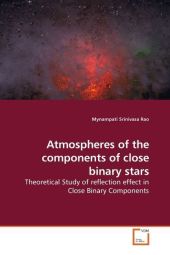 Neuerscheinungen 2010Stand: 2020-01-07 |
Schnellsuche
ISBN/Stichwort/Autor
|
Herderstraße 10
10625 Berlin
Tel.: 030 315 714 16
Fax 030 315 714 14
info@buchspektrum.de |

Mynampati Srinivasa Rao
Atmospheres of the components of close binary stars
Theoretical Study of reflection effect in Close Binary Components
2010. 192 S. 220 mm
Verlag/Jahr: VDM VERLAG DR. MÜLLER 2010
ISBN: 3-639-22553-8 (3639225538)
Neue ISBN: 978-3-639-22553-2 (9783639225532)
Preis und Lieferzeit: Bitte klicken
The study of close binary stars is of great importance in stellar astrophysics. The variability of the total light received from close binaries, provides the major source of information concerning stellar masses and dimensions. It conveys a substantial amount of geometrical, atmospheric and hydrodynamic information about these systems. The two major physical processes, other than obscuration of light during eclipses, that cause a variation of light and polarization with orbital phase are gravitational distortion and the reflection effect. The former phenomenon manifests itself through (i) mutual shape distortion and variation of projected aspect image to the observer and (ii) the associated emergent flux which results from this distortion (gravity darkening). The second phenomenon is the actual radiative interaction. Usually it is negligible in well separated systems, but is important in close binaries and also it is very complicated to model such systems. For theoretical modeling of such systems one has to consider realistic models which takes into account the radiative transfer, hydrodynamics, reflection effect.
Currently employed as a scientist at Indian Institute of Astrophysics, Bangalore, India. Presently working on radiative transfer problems in stellar atmosphere: namely effect of Compton broadening on spectral line formation, reflection effect in close binary components in 3D geometry and OGLE data analysis on eclipsing binaries.


